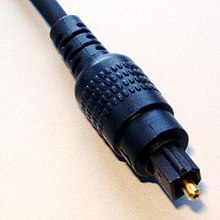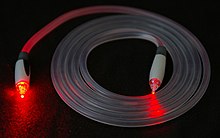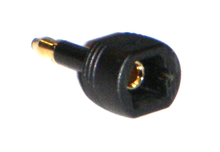TOSLINK
 Clear TOSLINK cable with a round connector for S/PDIF connectivity. | |||
| Type | Optical digital audio connector | ||
|---|---|---|---|
| Production history | |||
| Designer | Toshiba | ||
| Designed | 1983 | ||
| Manufacturer | Toshiba | ||
| Produced | Since 1983 | ||
| General specifications | |||
| Hot pluggable | Yes | ||
| External | Yes | ||
| Audio signal | S/PDIF bitstream. Originally limited to 48 kHz at 20 bits PCM. Extended by manufacturers to support additional formats.[citation needed] | ||
| Cable | Optical fiber, ~10 m (33 ft) maximum[1] | ||
| Pins | 1 | ||
| Connector | JIS F05 (JIS C5974-1993 F05) | ||
| Data | |||
| Width | Serial | ||
| Bitrate | |||
| Max. devices | 1 | ||
| Protocol | Serial | ||
TOSLINK (from Toshiba Link
Although TOSLINK supports several different media formats and physical standards, digital audio connections using the rectangular EIAJ/JEITA RC-5720 (also CP-1201 and JIS C5974-1993 F05) connector are by far the most common.[5] The optical signal is a red light with a peak wavelength of 650 nm.[3] Depending on the type of modulated signal being carried, other optical wavelengths may be present.[5]
History

The name is a registered trademark of Toshiba, created from TOShiba-LINK. Variations of the name, such as TOSlink, TosLink, and Tos-link, are also seen, while the official generic name for the standard is EIAJ optical.[citation needed]
ADAT Lightpipe or simply ADAT Optical uses an optical transmission system similar to TOSLINK, and is used in the professional music/audio industry. While the ADAT Lightpipe format uses the same JIS F05 connectors as TOSLINK, the ADAT Lightpipe data format is not compatible with S/PDIF.[citation needed]
Properties and issues
Due to their high attenuation of light, the effective range of plastic optical cables is limited to 5–10 m.[1] They can temporarily fail or be permanently damaged if tightly bent. Although less commonly available and more expensive than plastic optical fiber (POF) cables, glass or silica optical fibers have lower losses and can extend the range of the TOSLINK system.
Optical cables are not susceptible to electrical problems such as
Design

Several types of fiber can be used for TOSLINK: inexpensive 1 mm plastic optical fiber, higher-quality multistrand plastic optical fibers, or quartz glass optical fibers, depending on the desired bandwidth and application. TOSLINK cables are usually limited to 5 meters in length, with a technical maximum[1] of 10 meters, for reliable transmission without the use of a signal booster or a repeater. However, it is very common for interfaces on newer consumer electronics (satellite receivers and PCs with optical outputs) to easily run over 30 meters on even low-cost (0.82 USD/m 2009) TOSLINK cables. TOSLINK transmitters operate at a nominal optical wavelength of 650 nm.
Mini-TOSLINK

Mini-TOSLINK is a standardized
use these connectors that allow for the insertion of 3.5 mm analog (electrical) headphone output, microphone input, or mini-TOSLINK digital (optical) output.References
- ^ a b c d "SPDIF". epanorama.net. Retrieved 13 February 2022.
- ^ "New Fiber Optic Devices in Toshiba's TOSLINK Line-up Supports Development of High-speed Automotive LAN". Toshiba. 20 February 2003.
- ^ a b "Toshiba TOTX1701 TOSLINK Transmitter Module specifications". Archived from the original on 17 July 2011.
- ^ "What Is TOSLINK?". Toshiba Toslink FAQs. Archived from the original on 17 July 2011.
- ^ a b "Product guide, Fiber-Optic Devices TOSLINK(tm)" (PDF). 100621 digikey.com
- ^ "S/PDIF Information". Intel. 21 July 2017. Retrieved 3 April 2018.
- ^ "S/PDIF". PCMag Encyclopedia. Retrieved 13 February 2022.
- ^ Joseph D. Cornwall (31 December 2004). "Understanding Digital Interconnects". Audioholics.com. Retrieved 12 July 2007.
- Cnet. Archivedfrom the original on 21 December 2021.
- PC Magazine. Archivedfrom the original on 4 October 2015.
